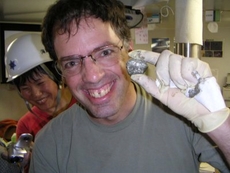

|
Glen SnyderResearch Scientist |

Ph.D (2001) University of Rochester  Back to Snyder's Main Page. Publication list (pdf). Curriculum vitae (pdf) Email: gsnyder@rice.edu Phone: (713)348-4054 Office: Keith Weiss Earth Science 330B |
Cycling of carbon and other elements in marine continental margins:
The marine sediment record has provided us with a window into ocean processes extending millions of years into the past. My work has focused on investigating the time scales upon which marine gas hydrates have accumulated along continental margins, and how long they have been actively diffusing gas to the surface. By looking at both pore fluid and sediment chemistry, present diffusive fluxes may be compared with the size of authigenic mineral fronts (both carbonates and barite) in order to determine the amount of time that microbial oxidation of methane has been ongoing in these systems. In addition, my research has focused on using 129Iodine (t1/2=15.6 Ma) and halogen geochemistry to determine accumulation times and rates of diagenetic release from organic matter in continental margin systems. Iodine ages indicate that the accumulation of organic matter in these systems occurs over tens of millions of years, while internal diagenetic cycling occurs on a time scale of several million years. Present interests include the use of uranium--series radioisotopes to determine the dynamics of authigenic mineralization above gas--charged systems.
I've carried out shore-based research on samples collected from the Blake Ridge (ODP 164), the Peru Margin (ODP 201),Marianas serpentinite mud volcanoes(ODP 195),and the Nankai Trough. Ongoing work is being carried out in the Gulf of Mexico. I have also been closely involved with Ryo Matsumoto's research group at the University of Tokyo, and have participated on cruises looking at one of the most significant seafloor gas seep sites in the world: the Umitaka Spur, Sea of Japan. The site hosts numerous pockmarks and slump features, as well as at least 35 closely spaced gas plumes, each up to 500m in diameter.
|